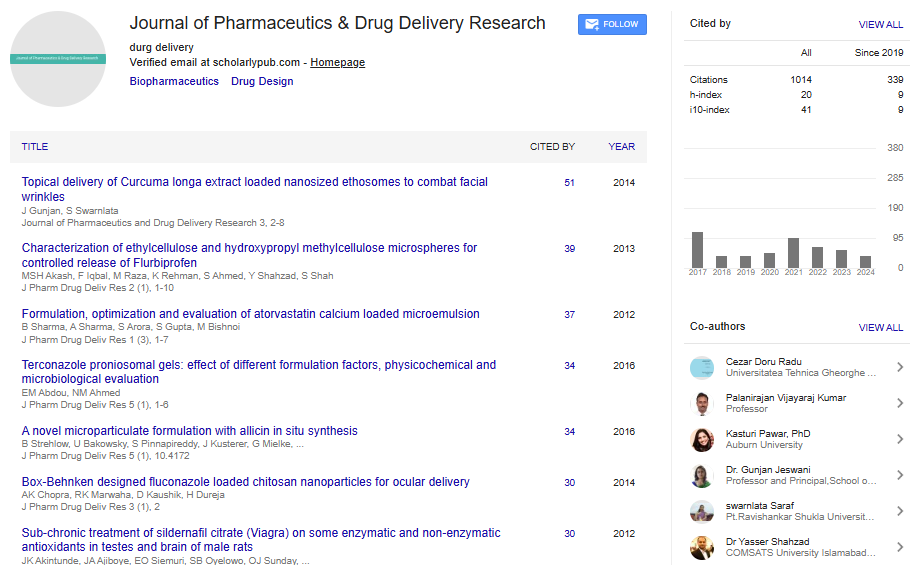Carbon nanotubes uptake in brain after intravenous injection in mice
Khuloud T Al-Jamal
King’s College London, UK
: J Pharm Drug Deliv Res
Abstract
Statement of the Problem: Brain disorders are on the rise accounting for almost 12% of world mortalities every year. Despite extensive research in drug development, brain disorders are still largely untreated due to the inability to deliver current therapeutics to the brain across the BBB. Chemically functionalized Carbon Nanotubes (f-CNT) constitute a novel class of nanomaterials with attractive physical, chemical and electronic properties. One interesting characteristic of f-CNTs is their ability to translocate across plasma membranes and enter the cells either passively by direct translocation across membranes or actively via endocytosis. In this study, the brain uptake properties of multi walled f-CNTs (f-MWNTs) were studied in in vitro and in vivo. Methodology: An in vitro model consisting of PBEC and astrocytes were co-cultured in a Transwell™ system. Percentage of BBB crossing of radiolabelled [111In] DTPA-MWNTs was assessed at 37°C up to 72 h or with an initial incubation at 4°C for 4 h. Ultrathin sections of PBEC were imaged using electron microscopy. Brain uptake in vivo was evaluated by SPECT/CT imaging and gamma counting following intravenous injection of [111In] DTPA-MWNTs in mice. Findings: The percentage transport of [111In] DTPA-MWNTs across PBEC (figure A) increased over the course of 72 h. The initial 4 h-incubation at 4°C resulted in a slight but significantly lower % transport than that obtained at 37°C (P=0.0005). This difference was abolished upon the re-incubation at 37°C at 72 h. The penetration process was captured by electron microscopy. The accumulation in mouse brain was confirmed by SPECT/CT imaging (figure B). Superior brain uptake of ~2-5% ID/g was measured by gamma counting after whole body perfusion. Conclusion & Significance: This is the first evidence of f-MWNTs translocation across the BBB. The significant reduction in BBB crossing at 4°C confirmed the uptake was driven by an energy-dependent pathway. Electron micrographs revealed transcytosis of f-MWNTs and its sequence as a function of time. f-MWNTs are able to access mice brain after i.v. injection.
Biography
Khuloud T Al-Jamal is a Chair of Drug Delivery & Nanomedicine at King’s College London (KCL). She was awarded the Overseas Research Award Scheme Scholarship from University of London (2000-2004) to complete her PhD in Drug Delivery at UCL-School of Pharmacy. She was awarded the prestigious CW Maplethorpe Research and Teaching Postdoctoral Fellowship from University of London (2005-2007) and started her academic career as a Lecturer at KCL in 2011. She was awarded the prestigious Royal Pharmaceutical Society Science Award in 2012 in recognition for her outstanding scientific achievements in the field of Nanomedicine. She has developed an extensive experience in “Designing and developing novel nanoscale delivery systems including dendrimers, liposomes, quantum dots, polymers, viral vectors, chemically functionalized carbon nanotubes and graphene oxide”. Her current work involves pre-clinical translation of novel nanomaterials designed specifically for drug, protein, nucleic acids and radionuclide delivery for therapeutic or diagnostic applications.
Email: khuloud.al-jamal@kcl.ac.uk
 Spanish
Spanish  Chinese
Chinese  Russian
Russian  German
German  French
French  Japanese
Japanese  Portuguese
Portuguese  Hindi
Hindi 
